Nikon 17-35mm f/2.8D IF-ED AF-S Review Round-Up
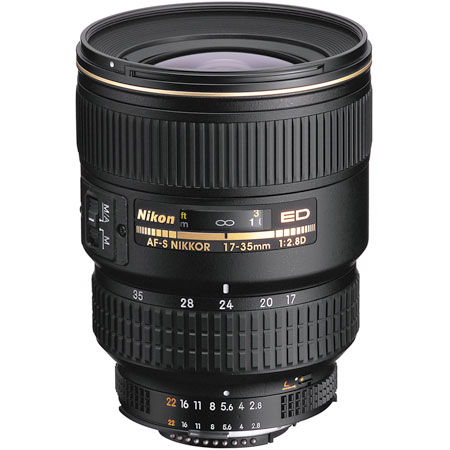
If you own or have used this lens, let us know what you think! Leave your comments and thoughts below. Get information and user reviews for this lens at Amazon: Nikon 17-35mm f/2.8D ED-IF AF-S Zoom Nikkor Lens for Nikon Digital SLR Cameras
Photo Zone
The Nikkor AF-S 17-35mm f/2.8D IF-ED is a professional grade lens and it delivers accordingly specifically regarding its superb build quality. The optical quality is on a very high though not unprecedented level. The center resolution is superb followed by generally very good borders. Distortions are quite pronounced at 17mm but not a real problem beyond. Vignetting is very well controlled except at 35mm @ f/2.8. CAs are very low for a zoom lens. All-in-all the performance is very similar to the AF-S 17-55m f/2.8G IF-ED DX in the overlapping range so for (APS-C) DSLR-only users it may make sense to stick to the dedicated lens. For a dual-use strategy (film + digital and possibly full frame DSLRs in the future) the AF-S 17-35mm f/2.8D IF-ED remains a quite obvious choice. … READ FULL REVIEW
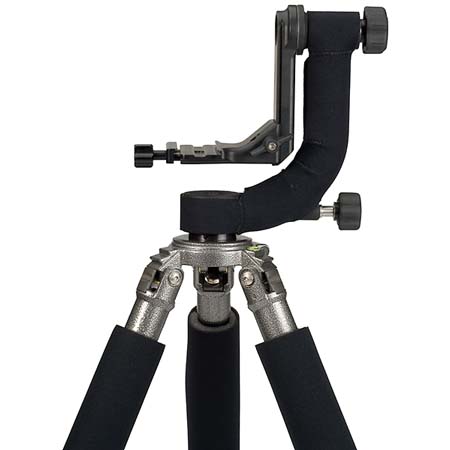 When is the Canon EF 600mm f/4 L IS Lens a featherweight? When it is mounted on a Wimberley Tripod Head II! If you are using a very large/heavy lens (300mm f/2.8 or larger), I highly recommend the Wimberley Tripod Head II and a solid tripod. ? ?When properly mounted on the Wimberley Tripod Head II, a heavy lens and camera body become nearly weightless to the photographer. Only two fingers are needed to move a setup such as the Canon EF 400mm f/2.8 L IS Lens mounted on a large camera body into position. ? ?Gimbal tripod heads such as the Wimberley Tripod Head II place the weight of the lens/camera setup below their pivot point. Thus, gravity pulls the setup into a level position. On the other hand, gravity attempts to cause the same camera/lens to flop over when mounted on a non-gimbal tripod head. ? ?Yes, many of the best non-gimbal heads (such as the Arca-Swiss B1 are rated for far more weight than my example lenses above. And they really can support the weight. But, you must fight against gravity when making adjustments. And if you don’t get everything tight, the lens can flop over into the tripod – with the potential for costly damage. And hold on tight if you are going to leave the mount loose for panning. Most of what I’ve said so far can also be said about the Original Wimberley Head. So why spend the money to upgrade if you already own the original Wimberley Head? To be honest, I was skeptical that a new version of the Wimberley Head would be worth an upgrade for me. But I am impressed at the changes Wimberley has made. The Wimberley Tripod Head II is a far more elegant solution to the problem solved so well by the original Wimberley Head. I have upgraded my kit with no regrets.
When is the Canon EF 600mm f/4 L IS Lens a featherweight? When it is mounted on a Wimberley Tripod Head II! If you are using a very large/heavy lens (300mm f/2.8 or larger), I highly recommend the Wimberley Tripod Head II and a solid tripod. ? ?When properly mounted on the Wimberley Tripod Head II, a heavy lens and camera body become nearly weightless to the photographer. Only two fingers are needed to move a setup such as the Canon EF 400mm f/2.8 L IS Lens mounted on a large camera body into position. ? ?Gimbal tripod heads such as the Wimberley Tripod Head II place the weight of the lens/camera setup below their pivot point. Thus, gravity pulls the setup into a level position. On the other hand, gravity attempts to cause the same camera/lens to flop over when mounted on a non-gimbal tripod head. ? ?Yes, many of the best non-gimbal heads (such as the Arca-Swiss B1 are rated for far more weight than my example lenses above. And they really can support the weight. But, you must fight against gravity when making adjustments. And if you don’t get everything tight, the lens can flop over into the tripod – with the potential for costly damage. And hold on tight if you are going to leave the mount loose for panning. Most of what I’ve said so far can also be said about the Original Wimberley Head. So why spend the money to upgrade if you already own the original Wimberley Head? To be honest, I was skeptical that a new version of the Wimberley Head would be worth an upgrade for me. But I am impressed at the changes Wimberley has made. The Wimberley Tripod Head II is a far more elegant solution to the problem solved so well by the original Wimberley Head. I have upgraded my kit with no regrets. 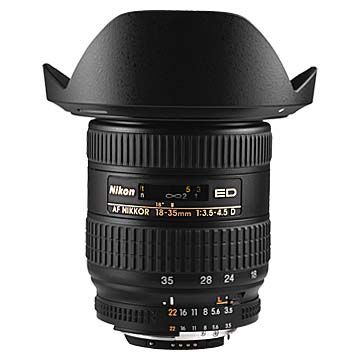
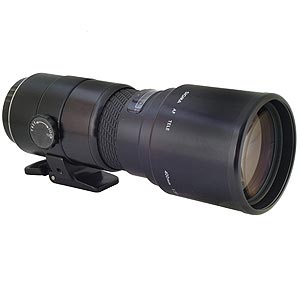
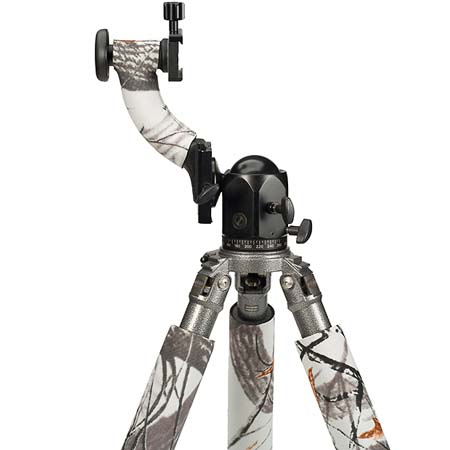 The Wimberley Sidekick is used to convert a strong tripod ballhead such as an Arca-Swiss Z1 Ballhead (see note below) to a gimbal-type head. A gimbal mount is typically used for mounting a super telephoto lens to a tripod. The weight of the lens and camera is positioned below the head’s pivot point. This takes away the tendency for the camera and lens to flop over (a potential catastrophe) and makes positioning the camera and large lens easy. A full-sized gimbal head such as the Wimberley Tripod Head II is the ultimate solution for the largest super telephoto lenses made, but the Wimberley Sidekick has some advantages. The first advantage is the cost – The Wimberley Sidekick is about half the cost of a full sized gimbal head. It is also a fraction of the weight. Of course, the full size Wimberley Tripod Head does not require the additional cost, size and weight of a ballhead. But, you probably want a ballhead anyway – and likely will want it with you as the Wimberley Tripod Head does not make a good smaller lens support. The Wimberley Sidekick makes an especially good long lens travel support. Space and weight savings are especially important when traveling by air and again, you will likely want to take your ballhead along anyway. The SideKick is a much smaller/lighter addition to your luggage than a full Wimberley. Like all Wimberley equipment, Wimberley Sidekick is very well made. Lock the Sidekick in place and nothing moves. If the functionality and purpose of this support meet your needs, it is a good purchase.
The Wimberley Sidekick is used to convert a strong tripod ballhead such as an Arca-Swiss Z1 Ballhead (see note below) to a gimbal-type head. A gimbal mount is typically used for mounting a super telephoto lens to a tripod. The weight of the lens and camera is positioned below the head’s pivot point. This takes away the tendency for the camera and lens to flop over (a potential catastrophe) and makes positioning the camera and large lens easy. A full-sized gimbal head such as the Wimberley Tripod Head II is the ultimate solution for the largest super telephoto lenses made, but the Wimberley Sidekick has some advantages. The first advantage is the cost – The Wimberley Sidekick is about half the cost of a full sized gimbal head. It is also a fraction of the weight. Of course, the full size Wimberley Tripod Head does not require the additional cost, size and weight of a ballhead. But, you probably want a ballhead anyway – and likely will want it with you as the Wimberley Tripod Head does not make a good smaller lens support. The Wimberley Sidekick makes an especially good long lens travel support. Space and weight savings are especially important when traveling by air and again, you will likely want to take your ballhead along anyway. The SideKick is a much smaller/lighter addition to your luggage than a full Wimberley. Like all Wimberley equipment, Wimberley Sidekick is very well made. Lock the Sidekick in place and nothing moves. If the functionality and purpose of this support meet your needs, it is a good purchase.  This is a big ball head. It’s massive, weighing in at around 4.5+lbs. I found it to be very solidly built and very sturdy. It’s big enough to hold just about any camera or lens you can lift onto it. The locking levers for the ball and the panoramic base are sturdy and efficient. It has adjustable ball tension, so you can set it for the weight of the lens in use. The downsides of this head are the weight and the smoothness of operation. If you have to carry it far in the field, the weight is as issue. If you are working indoors, it’s not a problem, but if you compare it to an Arca Swiss B1 – which is just as stable – you’re carrying around an extra 3lbs. The ball action isn’t particularly smooth. It gets better when you heavily load it, say with a 13 lb lens like a 600/4. You can live with it, it’s not aweful, but it’s not as smooth as other heads (most of which cost 2x or 3x the price of the 3038). Another potential negative point is that it uses the large Bogen hex QR plates. They work fine, but are significantly larger than, say the Arca Swiss QR plates. Still, if you need a BIG, stable ball head, you don’t have much money and you can live with the hex QR plates and a slightly sticky ball movement at times, the 3038 is a reasonable choice.
This is a big ball head. It’s massive, weighing in at around 4.5+lbs. I found it to be very solidly built and very sturdy. It’s big enough to hold just about any camera or lens you can lift onto it. The locking levers for the ball and the panoramic base are sturdy and efficient. It has adjustable ball tension, so you can set it for the weight of the lens in use. The downsides of this head are the weight and the smoothness of operation. If you have to carry it far in the field, the weight is as issue. If you are working indoors, it’s not a problem, but if you compare it to an Arca Swiss B1 – which is just as stable – you’re carrying around an extra 3lbs. The ball action isn’t particularly smooth. It gets better when you heavily load it, say with a 13 lb lens like a 600/4. You can live with it, it’s not aweful, but it’s not as smooth as other heads (most of which cost 2x or 3x the price of the 3038). Another potential negative point is that it uses the large Bogen hex QR plates. They work fine, but are significantly larger than, say the Arca Swiss QR plates. Still, if you need a BIG, stable ball head, you don’t have much money and you can live with the hex QR plates and a slightly sticky ball movement at times, the 3038 is a reasonable choice. 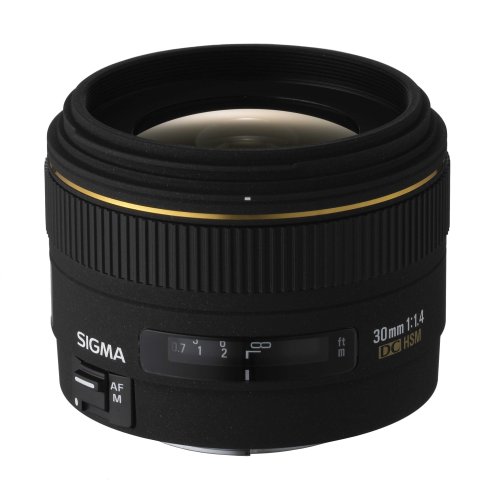 If you own or have used this lens, let us know what you think! Leave your comments and thoughts below.
If you own or have used this lens, let us know what you think! Leave your comments and thoughts below.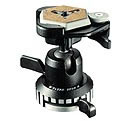 The 3055 is Bogen’s original “medium” ball head. It has a panoramic base like the 3038, but it’s not calibrated in degrees (the 3038 is). The ball and base actions are slightly “sloppy”. This isn’t a super-precision made device, but for $40, what do you expect! Though the ball tension might in theory be adjustable (depending on how hard you lock the locking lever), in practice it’s more or less “locked” or “free”. It takes the standard hex QR plates. Kirk can adapt it to take Arca Swiss type plates (they can do this for the 3038 too), but I’ve no idea why anyone would do this. The Arca Swiss QR plates are $40-$50 each. Why anyone would want to use them on a $40 ball head I don’t know. There’s also a Bogen version which takes thesmaller Bogen rectangular plates. I’d say the 3055 is adequate if you have a limited budget. There’s really nothing any better in a QR ballhead for the price. It’s OK with lenses up to a 300/4 or 400/5.6. I’ll admit to putting a 300/2.8 on one. It worked OK but it’s not something I’d recommend.
The 3055 is Bogen’s original “medium” ball head. It has a panoramic base like the 3038, but it’s not calibrated in degrees (the 3038 is). The ball and base actions are slightly “sloppy”. This isn’t a super-precision made device, but for $40, what do you expect! Though the ball tension might in theory be adjustable (depending on how hard you lock the locking lever), in practice it’s more or less “locked” or “free”. It takes the standard hex QR plates. Kirk can adapt it to take Arca Swiss type plates (they can do this for the 3038 too), but I’ve no idea why anyone would do this. The Arca Swiss QR plates are $40-$50 each. Why anyone would want to use them on a $40 ball head I don’t know. There’s also a Bogen version which takes thesmaller Bogen rectangular plates. I’d say the 3055 is adequate if you have a limited budget. There’s really nothing any better in a QR ballhead for the price. It’s OK with lenses up to a 300/4 or 400/5.6. I’ll admit to putting a 300/2.8 on one. It worked OK but it’s not something I’d recommend. 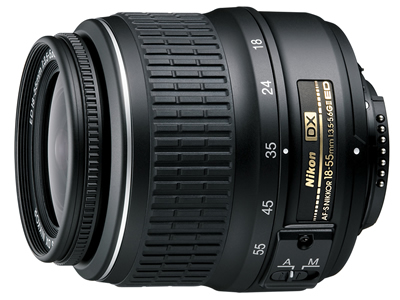
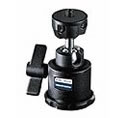 The 3262 comes in two versions, QR and non QR. The QR version doesn’t use the standard Bogen hex plates. It uses a smaller rectangular plate, which makes more sense on a medium-small ball head. I’ve used the non-QR version, so that’s what I’ll talk about. The 3262 is a simple head. No panoramic base, a single ball lock/unlock lever, no adjustable ball tension. Within these limits it works quite well. I’ve used it with lenses up to a 300/4 (with TC), but that’s the upper limit. I wouldn’t even think of putting a 300/2.8 on it. Overall, it’s a decent, solid ball head for an SLR with small (maybe medium) lenses. At the price, again you can’t really beat it.
The 3262 comes in two versions, QR and non QR. The QR version doesn’t use the standard Bogen hex plates. It uses a smaller rectangular plate, which makes more sense on a medium-small ball head. I’ve used the non-QR version, so that’s what I’ll talk about. The 3262 is a simple head. No panoramic base, a single ball lock/unlock lever, no adjustable ball tension. Within these limits it works quite well. I’ve used it with lenses up to a 300/4 (with TC), but that’s the upper limit. I wouldn’t even think of putting a 300/2.8 on it. Overall, it’s a decent, solid ball head for an SLR with small (maybe medium) lenses. At the price, again you can’t really beat it.